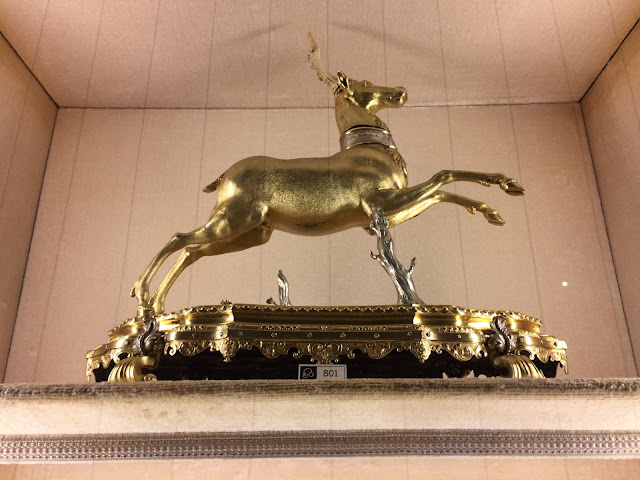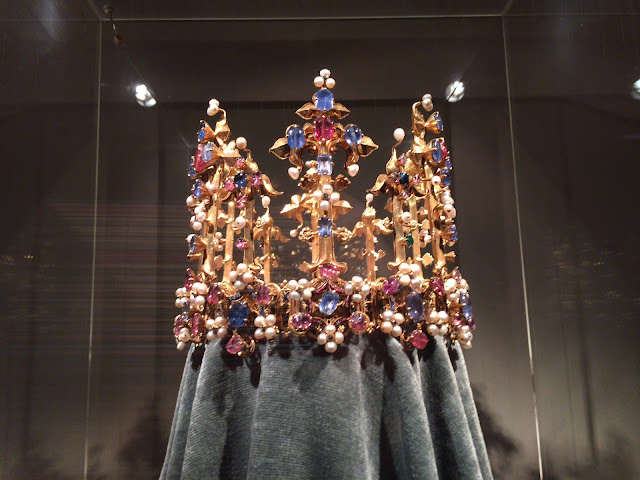レジテンツの中にある宝物館には、代々のヴィッテルスバッハ家の人々が作らせた、キンキラキンの宝物の数々が展示されている。
The Treasure Museum in the Residenz exhibits the treasures of the gold created by the Wittelsbach family of generations.
1314年にヴィッテルスバッハ家のルードヴィッヒ4世が、神聖ローマ皇帝になると、ミュンヘンはますます発展して、中世の最盛期を迎えた。
この時代には、ミュンヘンの街には多くのゴシック建築の建物が建てられた。
ルードヴィッヒ4世は、ハプスブルグ家のフリードリヒ3世と皇帝の座を巡り対立して戦争に発展。フリードリヒ3世を捕らえて、両者の間に妥協が成立した。
When Ludwig IV of the Wittelsbach family became the emperor of the Holy Romans in 1314, Munich grew even more and reached the heyday of the Middle Ages.
During this period, many Gothic buildings were built in the city of Munich.
Ludwig IV developed into a war by confronting Friedrich III of the Habsburgs over the throne of the Emperor. By capturing Friedrich III, a compromise was established between the two.
当時はローマ法王がアヴィニョンに囚われていた時代で、ルードヴィッヒ4世はローマに対立教皇を立ててが、周囲から反発を招き、その死後の混乱でヴィッテルスバッハ家は多くの領土を失ってしまう。
At that time, when the Pope was trapped in Avignon, Ludwig IV established a confrontational pope in Rome, but a repulsion from others aroused his surroundings, and the Wittersbach family lost many territories due to the confusion after death.
1516年4月23日、バイエルン公ヴィルヘルム4世は、”ビールは、麦芽、ホップ、水、酵母のみを材料とする”という有名なビール純粋法を制定した。
食糧に関する法律としては、世界最古と言われるこの法律は、バイエルンで作られたのだ。
時代は下り、1871年にプロイセンの支配の元にドイツ帝国が成立するにあたって、バイエルンは統一の条件として、このビール純粋法をドイツ全体に適用することを強く求めた。
反発する人々も多かったが、プロイセンはついに妥協してその要求を受け入れた。プロイセンにとっては、ドイツ統一のためには、バイエルンの参加は不可欠だったのだ。
On April 23, 1516, Wilhelm IV of the Bavarian enacted the famous beer pure law, "Beer is made from malt, hops, water and yeast only".
The oldest food law in the world was created in Bavaria.
As time went by, when the German Empire was formed under the rule of Prussia in 1871, Bavaria urged the Beer Pure Law to be applied throughout Germany as a condition of unification.
Although many repelled, Prussia finally made a compromise and accepted the request. For Prussia, the participation of Bayern was essential for the unification of Germany.
その後のバイエルン大公は、イタリアから多くの芸術家や建築家を招き、ミュンヘンにはルネサンス芸術が花開いた。
The subsequent Grand Duke of Bavaria invited many artists and architects from Italy, and Renaissance art flourished in Munich.
1618年に宗教戦争である30年戦争が始まり、バイエルンは旧教側として参戦したが、1632年には新教側のスウェーデン王グスタフ2世にミュンヘンの街を占領されるのなど、領土は著しく荒廃した。
In 1618, the 30-year war, which was a religious war, began, and Bavarian entered the war as an Old Religious Party, but in 1632 the territory was remarkably devastated, with the town of Munich being occupied by the Swedish King Gustav II of the new religion.
その30年戦争の最中、1634年と1635年にはペストが大流行して、ミュンヘンの街の人口の3分の1が亡くなったと言われている。
During the 30-year war, plagues were prevalent in 1634 and 1635, killing one-third of the city's population.
日本にいると、ドイツの歴史というものはよく語られ、また本なども比較的手に入れやすい。
しかし、バイエルンの歴史など、あまり取り上げられないし、そうした本もほとんどない。
ミュンヘンという街に来て、いろいろな所を巡っていると、ドイツの歴史ではなくて、ミュンヘンあるいはバイエルンの歴史が、とても知りたくなった。
In Japan, German history is often talked about, and books are relatively easy to obtain.
However, the history of Bavarian is rarely covered, and there are few such books.
When I came to Munich and visited various places, I wanted to know the history of Munich or Bavaria, not the history of Germany.
(Translated by Google Translate)








コメント
コメントを投稿